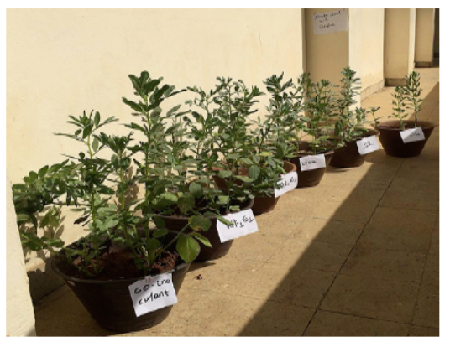


Indian Journal of Science and Technology
Year: 2024, Volume: 17, Issue: 15, Pages: 1507-1514
Original Article
Emebet Kibkab1*, Nega Berhane2
1Department of Agricultural Biotechnology, Institute of Biotechnology, University of Gondar, Gondar, Ethiopia
2Department of Medical Biotechnology, Institute of Biotechnology, University of Gondar, Gondar, Ethiopia
*Corresponding Author
Email: [email protected]
Received Date:06 February 2024, Accepted Date:01 March 2024, Published Date:04 April 2024
Objectives: To assess the effectiveness of the potential of the Rhizobium leguminosarum bv.viciae strain in two different soils with the Ashebka faba bean variety as the host plant. Method: Soil physicochemical analysis and the most probable number were done according to their standard procedure. The pot was laid out in a complete randomized design with three replications. Three top strains were selected as inoculants for faba beans grown on the slightly acidic Shentia soil and the slightly neutral Dabat soil with their control. The symbiotic effectiveness of the strains was evaluated based on plant agronomy and the total nitrogen of the plant. The results of the strains were analyzed by SPSS version 26. Findings: The results of shoot dry weight show that all strains accumulated 81mg/p for isolate WK1E1, followed by 85mg/p for isolate GR1E1, and finally 87mg/p-1 for isolate co-inoculant on Dabat soil, and 78mg/p for isolate WK1E1, followed by 82mg/p for GR1E1 and finally 85mg/p-1 for co-inoculant Shentia soil. The nodule number record range from 138mg/p-1, and 173mg/p-1 for isolate WK1E1 and co-inoculate, respectively for Dabat site. 139mg/p-1 for isolate WK1E1 and 165 mg/p-1 for isolate co-inoculate Shentia site. Maximum mean shoot dry mass (91mg/p) was scored by positive nitrogen and the minimum (29mg/p) by the negative control nitrogen treated control for Dabat. The maximum mean shoot dry mass (86mg/p) was scored by the positive nitrogen treated control and the minimum (29mg/p) by the negative control for Shentia. For Dabat soil, the relative effectiveness expressed as a percentage of shoot dry mass of inoculated over total nitrogen control, showed that 89, 93, and 95.6 and Shentia soil the relative effectiveness expressed as a percentage of shoot dry weight of inoculants over nitrogen treated control, showed that 90.6, 95.3, and 98.8 for isolates WK1E1, GR1E1, and co-inoculant, respectively for both soils. Positive correlations were also observed concerning nodule numbers with other agronomic parameters. Novelty: No such testing was attempted in that study area before, and this new idea came because the Rhizobium leguminosarum bv.viciae isolates tested their survival, compatibility, and effectiveness in two different soils with Ashebka faba bean as the host.
Keywords: Ashebka faba bean, most probable estimation, Rhizobium leguminosarum bv.Vicae, inoculums, symbiosis
© 2024 Kibkab & Berhane. This is an open-access article distributed under the terms of the Creative Commons Attribution License, which permits unrestricted use, distribution, and reproduction in any medium, provided the original author and source are credited. Published By Indian Society for Education and Environment (iSee)
Subscribe now for latest articles and news.